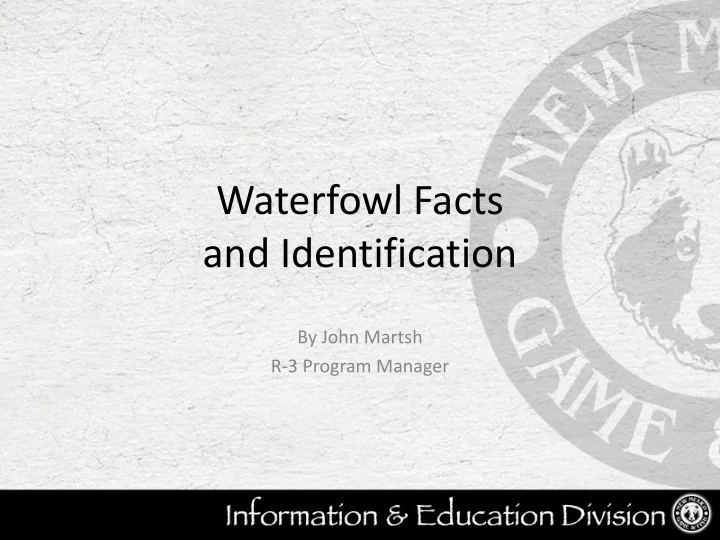

Waterfowl Facts and Identification By John Martsh R-3 Program Manager
North American Flyway Map Credit: U.S. Fish and Wildlife Service – Migratory Bird Program
Prairie Pothole Region Credit: Prairie Pothole Joint Venture website
Canada’s Boreal Forest Credit: Boreal Songbird Initiative
Relative Sizes of Waterfowl Credit: USFWS
New Mexico Waterfowl • A total of 26 species of waterfowl are found in New Mexico. – 10 Dabbling Ducks – 9 Diving Ducks – 1 Stiff-tailed Duck – 4 Geese – 2 Swans
Body Parts for Identification Pay attention to the shape and colors of the: • Bill, head, wings (specifically speculum) and chest, on waterfowl. • Drab versus bright colors to identify gender. • Can you see vermiculation (pattern of dense, irregular gray lines) or the speculum (colorful portion of drake or hen’s wing)?
Waterfowl Life Cycle Once mature, waterfowl go through a yearly cycle: Fall Migration=>Winter=>Spring Migration=> Pre-Nesting=>Nesting=>Hatching=>Brood Rearing=>Post Breeding=>Molt Females have shorter lifespans than males due to stress of breeding, nesting and raising young. Wild swans live longest, averaging 20-30 years, geese average 10-24 years and ducks 5-10 years.
Waterfowl Nomenclature Artwork by John Martsh
Ducks • Divided into 2 broad categories. • Size difference between drakes (males) and hens (females). • Drakes are more colorful than hens, which tend to be drab, mottled colors.
Dabbling Ducks • Also called puddle ducks. • Feed by bobbing their head underwater. • Prefer smaller, shallow bodies of water with nearby cover. • Legs exit from the middle of their belly. • Swim with tail high above water’s surface. • Spring into the air on take off. • More likely than divers to feed in agricultural fields because they walk and run well on land.
Mallard Credit: Mark Watson
Mallard Credit: USFWS
Mexican Mallard Credit: Jim Stuart
Northern Pintail Credit: Jim Stuart Credit: Jim Stuart
Northern Pintail Credit: USFWS
Gadwall Credit: Jim Stuart
Gadwall Credit: USFWS
American Wigeon Credit: Jim Stuart
American Wigeon Credit: USFWS
Northern Shoveler Credit: Jim Stuart
Northern Shoveler Credit: USFWS
Wood Duck
Wood Duck Credit: USFWS
Green-Winged Teal Credit: Jim Stuart
Green-Winged Teal Credit: USFWS
Blue-Winged Teal Credit: Jim Stuart
Blue-Winged Teal Credit: USFWS
Cinnamon Teal Credit: Mark Watson
Cinnamon Teal Credit: USFWS
Diving Ducks • Feed by diving completely underwater. • Prefer larger, open, deep bodies of water and typically swim towards the middle. • Legs exit towards the rear of the body. • Swim with tail close to the water. • “Walk” along water’s surface on take off.
Common Goldeneye Credit: Jim Stuart
Barrow’s Goldeneye Credit: USFWS
Goldeneyes Credit: USFWS
Canvasback Credit: Jim Stuart
Canvasback Credit: USFWS
Redhead Credit: Mark Watson
Redhead Credit: USFWS
Ring-necked Duck
Ring-necked Duck Credit: USFWS
Lesser Scaup Credit: Jim Stuart Credit: Jim Stuart
Lesser Scaup Credit: USFWS
Bufflehead Credit: Mark Watson Credit: Jim Stuart
Bufflehead Credit: USFWS
Common Merganser Credit: Mark Watson Credit: Mark Watson
Common Merganser Credit: USFWS
Hooded Merganser Credit: Mark Watson Credit: Mark Watson
Hooded Merganser Credit: USFWS
Stiff-tailed Duck • Long, stiff-tail feathers, which are raised when the bird is resting. • Long, puffy bill. • Legs are set far back on body, making walking on land difficult. • This duck rarely leaves the water.
Ruddy Duck Credit: Jim Stuart Credit: USFWS
Ruddy Duck Credit: USFWS
Geese • Geese are larger waterfowl than ducks, averaging about 6.5 pounds and 30” in length. • Except for a slight size difference, males and females appear identical. • Geese are quite vocal. • Generally stick to larger flocks than ducks. • Flocks are typically family groups.
Ross’ Goose Credit: USFWS
Snow Goose Credit: John Martsh
Snow Goose Credit: USFWS
White-fronted Goose Credit: USFWS
White-fronted Goose Credit: USFWS
Canada Goose
Canada Goose Credit: USFWS
Swans • Swans are the largest waterfowl, averaging a weight of 22 pounds and 56” in length. • Males and females appear identical except for a slight size difference. • Tundra and trumpeter both have black bills with white bodies, but mature tundra has a yellow spot on bill in front of eye. • Trumpeter is much heavier and longer.
Tundra Swan Credit: Mark Watson
Tundra Swan Credit: USFWS
Trumpeter Swan Credit: Jim Stuart
Trumpeter Swan Credit: USFWS
Conclusion • Find a location with resident waterfowl year round. • Use waterfowl identification booklet or cell phone application. • Practice identifying ducks, geese and swans. • Identify species. • Identify gender.
Recommend
More recommend